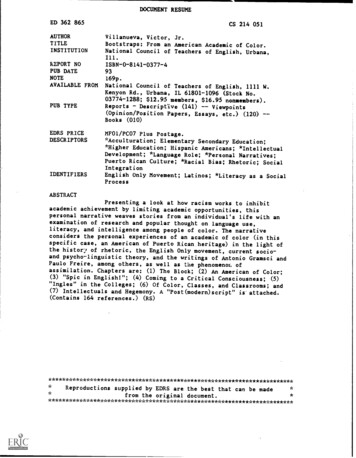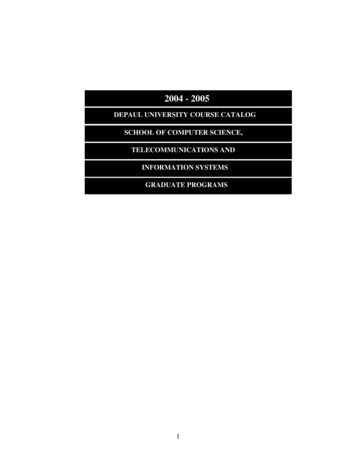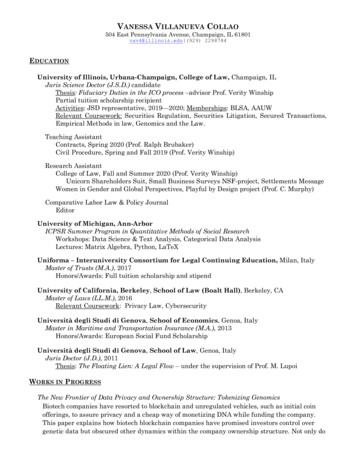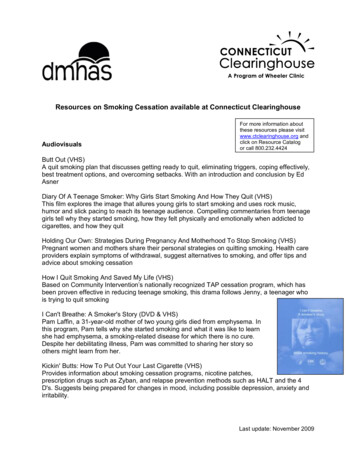
Transcription
DOCUMENT RESUMEED 362 865AUTHORTITLEINSTITUTIONCS 214 051Villanueva, Victor, Jr.Bootstraps: From an American Academic of Color.National Council of Teachers of English, Urbana,REPORT NOISBN-0-8141-0377-4PUB DATE93NOTE169p.AVAILABLE FROM National Council of Teachers of English, 1111 W.Kenyon Rd., Urbana, IL 61801-1096 (Stock No.03774-1288; 12.95 members, 16.95 nonmembers).PUB TYPEReports - Descriptive (141) -- Viewpoints(Opinion/Position Papers, Essays, etc.) (120) -Books (010)EDRS PRICEDESCRIPTORSIDENTIFIERSMF01/PC07 Plus Postage.*Acculturation; Elementary Secondary Education;*Higher Education; Hispanic Americans; *IntellectualDevelopment; *Language Role; *Personal Narratives;Puerto Rican Culture; *Racial Bias; Rhetoric; SocialIntegrationEnglish Only Movement; Latinos; *Literacy as a SocialProcessABSTRACTPresenting a look at how racism works to inhibitacademic achievement by limiting academic opportunities, thispersonal narrative weaves stories from an individual's life with anexamination of research and popular thought on language use,literacy, and intelligence among people of color. The narrativeconsiders the personal experiences of an academic of color (in thisspecific case, an American of Puerto Rican heritage) in the light ofthe histor7 of rhetoric, the English Only movement, current socioand psycho-linguistic theory, and the writings of Antonio Gramsci andPaulo Freire, among others, as well as the phenomenor. ofassimilation. Chapters are: (1) The Block; (2) An American of Color;(3) "Spic in English!"; (4) Coming to a Critical Consciousness; (5)"Ingles" in the Colleges; (6) Of Color, Classes, and Classrooms; and(7) Intellectuals and Hegemony. A "Post(modern)script" is* attached.(Contains 164 references.) *************************Reproductions supplied by EDRS are the best that can be madefrom the original ******************************
.4060.fir*1.a.sr,4,AU"PERMISSION TO REPRODUCE THISMATERIAL HAS BEEN GRANTED BYDEPARTMENT Of EDUCATIONMice of EducaticoM Rasearch and ImprovementEDUCATIONAL RESOURCES INFORMATIONNNW( S.CENTER (ERIC)as)(This document has been reproduced(*cowed from the person or organizationotiginating dmade to improve0 Minor changes have beenreproduction ctuahpvTO THE EDUCATIONAL RESOURCESINFORMATION CENTER (ERIC)"POIMIS Of view or opinions stated In this docuTent do not TecesSanly represent officialOEM Pantion of policyY MumAAAAAhIta".32a nt.ger
Bootstraps:From an American Academicof ColorVictor Villanueva, Jr.Northern Arizona UniversityOPNational Council of Teachers of English1111 W. Kenyon Road, Urbana, Illinois 61801-1096'lI
NCTE Editorial Board: Keith Gilyard, Ronald Jobe, Joyce Kinkead, Louise W.Phelps, Gladys Veidemanis, Charles Suhor, chair, ex officio; Michael Spooner,ex officioProject Editor: William TuckerInterior Design: Tom Kovacs for TGK DesignCover Design: Doug BurnettNCTE Stock Number 03774-1288 1993 by the National Council of Teachers of English. All rights reserved.Printed in the United States of America.It is the policy of NCTE in its journals and other publications to provide aforum for the open discussion of ideas concerning the content and the teachingof English and the language arts.Publicity afforded to any particular point of view does not imply endorsementby the Executive Committee, the Board of Directors, or the membership atlarge, except in announcements of policy, where such endorsement is clearlyspecified.Library of Congress Cataloging-in-Publication DataVillanueva, Victor, 1948Bootstraps : from an American academic of color / VictorVillanueva, Jr.p.cm.Includes bibliographical referencesISBN 0-8141-0377-4 : 16.951. Villanueva, Victor, 1948- 2. English languageStudy andteachingUnited States. 3. Hispanic American college teachersBiography. 4. English teachersUnited StatesBiography.I. ]4
ContentsGood Debts: Words of IndebtednessviiPrologueIIIxiThe BlockAn American of Color115"Spic in English!"IV Coming to a Critical ConsciousnessV Ingles in the CollegesVI Of Color, Classes, and ClassroomsVII Intellectuals and HegemonyA thor1515
Good Debts: Words of IndebtednessI think of how it would be if the numbers of academics of color actuallyreflected the demographics of the countryOnce a year I meet with others who are of color and are involvedin language teaching. I tend to be the only one who teaches rhetoric:some do English education; some bilingual education; some teachliterature, ethnic and traditional; there is usually a poet or two amongus. Our teaching spans all grade levels. We are brown and black andyellow and red. At those meetings, we are the guests of NCTE. Butour main host is Dr. Sandra Gibbs, the director of special programsfor NCTE. She has no idea what those days mean to me. I don't thinkI know her politics, really. But I know she has a quick ear for the latentand a quick tongue for making the latent explicit. I'm glad she's there.A special thank you.I am glad to be among other professionals of color for those fewdays. In those few days, we !augh, and we swap stories which tell ofour ways, ways which tell of our particular cultures, ways we have incommon as people of color. And we work. And our work reflects thethings we have in common with many of our fellow professionals, andour work reflects the things we see and hear and feel, aggravating thingssometimes, painful things.So it is that somewhere along the way I had thought it would be agood idea to have a collection of essays that would depict how thestruggles of people of color continue after goals are reached, after"making it:' I still think it's a good idea. Rumor about the idea reachedMichael Spooner, the person in charge of publications for NCTE. Heasked if I had a book in the works. Only an idea.Meanwhile, Bryan Short, a co-worker at Northern Arizona, had reada mixed-genre piece I had written for a collection on critical theory;he had also read a more straight-academic piece I intended to submitto a journal. He preferred the mixed genre, said the writing was moreeffective, the message worth saying, the time right. "Write a book:' Heis more than well-versed in the ins and outs of the academy, scholarshipto institutional politics. I trust his judgment.vii
viiiBootstrapsBefore that, Anne Ruggles Gere responded to a mixed-genre essayI had written for the English Journal. She said there was a book there.I didn't see how at the time. But I had long ago learned that she knewthings about this business that I would never understand (though shewasn't always aware that I didn't understand them). And she knewthings about my potentials that I didn't always know. She never didlet me get away with anything in graduate school, wouldn't let me liedown when I grew tired of poverty, indignity, insecurity, when I knewI didn't belong and couldn't do it. Anne and Bryan and Michael arethe folks immediately responsible for my pursuing this book. Thanks.To these, I must add William Irmscher, my first boss when I was aTeaching Assistant (short for teaching-on-assistant-pay). Along withAnne, Irmscher kept me in the act when I felt like the Judy to theinstitution's Punch. He worked behind the curtain, my knowing of hishelp only through rumor: Irmscher, the Indonesian puppetmaster.Indonesian puppetmasters are believed lo shape destinies.There is Sharon Crowley. There is her company: co-worker, critic,call one day, after my wife and Iand friend. Hers was thedecided that we would leave the loneliness of the academic profession;Sharon's the call that allowed me to give academics another chance, adecision I have not yet come to regret. We're in the same business,Professor Crowley and I, rhetoric and composition, attending the samemeetings, knowing some of the same people, reading the same journalsand books, having similar ideas. We have fun together. And even atwo-minute talk in the halls is often the seed for hours of fruitfulthought. Yet she is less a mentor than my academic Papo. Papo wassomething of my protector on the block back in Bed-Stuy, the bad-assthat no one messed with. Sharon protects me from institutional politics,a discourse I will likely never break into.Special others. There is Bill Grabe, who casualty tosses into my boxlinguistic things I would want to read. And my bosses at NorthernArizona (named after furniture: chairs; Freire goes on about dehumanization), Paul Ferlazzo and Sharon and Susan Foster-Cohen. I couldget on in Bed-Stuy. I'm not sure I could in the academy, the day-to-day, without these chairs. Breaking into the professional academiccommunity is tricky business for most, I'm sure. Harder still for theperson of color still weighted down by a GED, my personal psychologicalbaggage of failure. Thanks to those who believe in me.Since I am mixing genres even here, a mix of dedication andacknowledgment. I think it important to acknowledge those editorsand publishers who accepted essays I have written in the past which7
Good Debtsixappear here in larger chunks. I've been going on about the same stufffor some time now, so I bypass the fragments and I bypass thingswritten for NCTE. What remains includes a chapter in Writing With:New Directions in Collaborative Teaching, Learning, and Research,edited by Sally Reagan, Thomas Fox, and David Bleich, to be publishedby State University of New York Press (1993); an article which appearsin PRE/TEXT (1993); and a chapter which appeared in Politics ofWriting Instruction: Postsecondary, edited by Richard Bullock and JohnTrimbur, published by Boynton/Cook in 1990. My thanks to theeditors, especially John Trimbur, for having encouraged me to write.Thanks to the publishers for allowing what I had written to appear inprint. Thanks, also, to the NCTE Editorial Board for taking the riskof accepting this somewhat idiosyncratic book. And thanks to BillTucker, the copy editor, for laboring ever so sensitively over my everyword.Then again, I wouldn't have written, and wouldn't be writing now,if Mami hadn't pushed for linguistic assimilation and if Dad hadn'tremained grateful for being an American while being audibly criticalof America. I wouldn't be writing if the local parochial school hadn'thad its doors open to the poor. I wouldn't bother if students, many ofthem teachers themselves, hadn't, in various ways, let me know that Iam in the right job.And there is Carol and the babies: the preschoolers, the schoolers,the grown up, my babies all. My babies give my life its greatest meaning.Perhaps my greatest struggles have been in trying to meet the institution'sdemands while remaining a parent in very traditional ways, not justleaving the raising to Carol or part-time parents-for-hire. None of itgets done as well as I'd like, but all of it does get done. And thesemblance of balance comes in my never not being a father (which Ihope makes for paternity more than paternalism in classrooms).From Carol I continue to learn how to think in large, global, systemicterms, in terms of politics and political economies. She helps me putour lives in contexta global, economic contextwhich saves mefrom the self-fulfilling prophecy that dooms the many labelled "at risk."Much of the final chapter to this book, the post(modern)script, istantamount to plagiarism.From Carol I learn that to be critical does not have to mean to becynical. From Carol I know of magic, of loving. And knowing loveopens up possibilities, allows one to be utopian in the midst of all thatsometimes seems hopeless. Ché Guevara believed revolutions begin
xBootstrapswith love. Maybe loving a country and its peoples can provide forrevolutionary changemore than mere reforms: true equity. Maybe.And loving brings me full circle. A Mami and Dad: que Dios tebendigan.
Prologue"It's nobody's business," Mami would say. But I can't just say nothingabout how it is I cone to know some things, come to regard sometheories on literacy and writing and rhetoric as more tenable thanothers, and how I come to think the ways I do about racism andethnocentricity and the class system, and why I can believe in thechances for revolutionary changes in attitudes about racism and ethnocentricity and class through language and the classroom. I can't justsay nothing. But there's Mami and the Latino ways: private thingsshould remain private. So, play out the tension.Thoughts. The I speaking to its me.The portorican boy (that's how they say itportorican) looks at theexperiences of the African American and says, "That's racism. Theycan't escape their skin. No one will let them." Mami always did carryon about his good haircurl, but no kinkhis nariz fino, a Romannose, she used to say. Blancito on the block. Steven Figueroa lookedAsian somehow. Enchi (enchilada) looked more Mexican. The othersIcoked mulatto or black. He's the white kid among the browns andblacks of Brooklyn's Williamsburg and Bedford-Stuyvesant.Long later, a beard, long hair. The hair is not intended as a politicalstatement, only a response to too many years of "get a haircut" and"shave again": dress codes in school, seven years in the army. Standingby a hamburger stand in the American midwest. someone speaks tohim in a decidedly foreign tongue. Turns out to be Farsi. He mustlook Iranian. Trying to enter the All-American Crafts Fair in the Heartof America, the man behind the ticket counter asks if he is Indian,from India. He must look Indian. Sitting in a bus in Seattle, a Japaneselooking fellow handing out fliers for a Christian radio station says,"Jesus loves you, my little Jewish friend." He must look Jewish. Thewhite kid in Brooklyn ain't just white elsewhere. He's some sort ofethnic.Shakespeare saw Othello as black. Othello the Moor, el inorm.There's a U.S. army base in Puerto Rico called El Morro. El Blancito,xiI0
xiiBootstrapsthe white one in Brooklyn, not white elsewhere, is more the Moorthan the Puerto Rican Boricua Indian or the West African blackapparently, a hint of some ancient Islamic strain. "This is my son,Fidel," says his dad. Fidel, the bearded, the white guy who would notbe quite white on a Seattle bus, a Kansas City crafts fair, a suburbanhamburger stand. There are other Caribbean Latinos who look likehim, some famous (or infamous). He's just not typical of the stereotypical. So many subtleties to the absurdities of racism."Congratulations on your book," says a co-worker. The department'sbrag sheet had announced his receiving a contract, a book on languageand rhetoric and teaching from the perspective of a person of color:Bootstraps. But the colleague couldn't just leave it at congfatulations:"Still, I have a hard time seeing you as someone of color." My guessis that he meant that as a compliment, likely having something to dowith competence. The colleague must see "color" as brown and blackand not quite as able (though the incompetence is a social problem,not a genetic predisposition, no doubt). With competence, the Moorishhue goes undetected.I didn't always see myself as a person of color. Nor did I questionmy competence back then, though the more the awareness of color,the greater the insecurity as I grew older. But in those early years I wasel blancito, after all. I could see myself as poor, the working class. Andthere is a connection between class and color, some overlap, mattersto be discussed later in this book. But "color," back then, meant shadesof brown, black. It hadn't occurred to me that the Puerto Rican wouldsomehow not be white, no matter the pigment. My father's childhoodfriend, Archibalno dSydney Radcliffe, Anglo named, blue eyed,blond haired. White? Likely not: many-generationed Puerto Rican,monolingual in Spanish. If not white, a Spic. No speak English, nospeak, speak, spic. Language is also race in America. Spanish is color.Yet color didn't really strike me, not really, till college, as I attemptedto move within the class system, and as more of America's culturalheritage, seen through literature and through rhetoric, became clear.W E. B. DuBois told me of the souls of black folk and the degree towhich education does not overcome racism. Faulkner introduced meto the octoroon, who for all his or her success, not being seen as blackelsewhere, could not transcend a black genetic line. Of course thePuerto Rican is colored: what with el morro, and the West African,and Columbus's Indians; what with my grandmother, Mama Pina,looking like the stereotypical American Indian; what with my brown-
Prologuexiiiskinned, curly haired sister, and my brown daughter, and my Spanishsurname. Octorican.He sees himself as essentially of the same race as the majority, andknows that sometimes they do too, and he wonders how it is that whathe hears and sees and feels and never seems able to escape is racismnevertheless.He looks at the experiences of the Mexican immigrant and says,"That's ethnocentrism; they're Mexican; they're immigrants." His Dadwould tell of co-workers who would ask if he had been in the portoricanarmy. "The American. We're American citizens film birth," he'd say."We're citizens." His Dad would tell of Operation Bootstrap, GovernorMainz Mann's Puerto Rican prosperity program. Corporations likePfiezer prosper, tourism does well, the Atlantic fleet does wellwhilethe majority of the Puerto Rican people have the honor of rankingsecond in the nation for poverty and for food-stamp allotment, secondonly to American Indians. The Indian reservations: colonies within theU.S.; Puerto Rico, a U.S. possession, a colony; both have the inordinateeconomic dependence of neocolonialist states. Texas and Utah andArizona and New Mexico and Colorado: colonies once. And California.The natives are not immigrants, yet not equal to other citizens.The colonized. "You Spanish?" "Where you from?" "What's yournational origin?" "What's your ethnic heritage?" Folks are quick to tellof their German or their Irish. They search for roots. Their roots arenever exposed. No one seems to see their roots. Seems like everyonesees his. He doesn't think to ask them roots questions in the waythey're compelled to ask him, and he doesn't see that they ask eachother as a matter of course.A manuscript in the mail: "Would you please review this bibliographyof Mexican American literature?" He enjoys the literature well enough.Galarza and Ar lya and others. But he knows more of Chaucer andMilton and Yeats than of Puerto Rican writers like Piri Thomas orTato Laviera or Nicolasa Mohr. He knows Mexicans less. He has beenstereotyped again: Hispanic, a monolith, all the samein everything;all know one another; all read the same things. He doesn't even teachliterature as a matter of course, ethnic or otherwise.I teach writing, in English; and know next to nothing about bilingualeducation from a professional perspective. I teach and study the Greeksand the Romans and their influence on contemporary English discourseAmerican discourse. I study and talk about modern rhetoricians like Kenneth Burke or Wayne Booth, postmodern Frcnch cultural
xivBootstrapscritics who speak in essentially rhetorical terms, like Foucault or Derrida.I am professionally distanced from the Hispanic in many ways. Noteven Paulo Freire quite qualifies as Hispanic to me, insofar as I havecome to know of him through non-Hispanic channels, and insofar ashis Brazilian Portuguese is more foreign to me than Greek. I've probablylearned more about the histories and the political economies of Mexicoand Latin America from my non-Hispanic wife.I have never stopped trying to assimilate. And I have succeeded inall the traditional ways. Yet complete assimilation is deniedtheHispanic English professor. One can't get more culturally assimilatedand still remain other. People of color carry the colony wherever wego. Internal colonialism: a political economy, an ideology, a psychology.And so he recognizes that despite the cultural differences betweenPuerto Ricans and the mainstream he sees himself as essentially of thesame culture as the majorityeven the transmitter of the majoritycultureno immigrant. And he wonders how it is that what he hearsand sees and feels and never seems able to escape is ethnocentrismnevertheless.He looks at the experiences of the African American speaker ofBlack English, the Spanish-speaking Mexican American, Puerto Rican,or other Latino, and says, "They lack sophisticated speaking skills inthe language of the majority:' Then he remembers having spokenSpanish and Black English and the Standard English required at theschool, seems like always, and he wonders how it is that he got sortedoutside the mainstream, relegated to a vocational high school, a highschool dropout. He is racially white, despite the subtle.hue, a nativeborn citizen and lifetime resident of the continental United States, aquick study in linguistic code switching, a Ph.D. in the language andthe literary traditions of the majority, a reproducer of those traditions.And still, other. And he realizes that there is more to racism, ethnocentricity, and language than is apparent, that there are long-establishedsystemic forces at play that maintain bigotry, systemic forces that caneven make bigots of those who are appalled by bigotry. Now to try tomake that realization explicitly understood. It is an aim for whatfollows: this book.He has made it by the bootstraps: GED to Ph.D.an Americansuccess story. But he knows that for most like him the bootstraps breakbefore the boots are on, that too many have no boots. So he tries tograsp at concepts like colonialism and ideology and hegemony and theways they are imbricated 'with language, tries to figure this out: thisbook.3
PrologueXVSo how come a GED? I'll accept some blame, sure. I remembergiving up. But systemic forces had an influence, surely: matters ofcolonialism, old-fashioned and neo- and internal; matters of race andculture and class and their manifestations in speech.Then how a doctorate? There are always some who get through.Some must get through, a matter of ideological credibility in the landof opportunity, the workings of hegemony. Yet internal colonialismremains, never quite equity.How the doctorate? I deserve some credit, sure: maturity andmotivation; the bliss of ignorance, not always recognizing the systemic;and with the naiveté, the edge in being critical, in recognizing thesystemic. A contradiction. It plays out this way: I didn't know what Iwas getting into, but knew I was getting into something not intendedfor the likes of me.There are always the contradictions. Antonio Gramsci makes muchof them. So does Paulo Freire. In this case there is the contradictionof achieving the inaccessible through the combination of cultural literacywith critical literacy. They are not dichotomous, necessarily. Both arenecessarily important to the American of color, the colonized, the onewho is American and yet other.Containing contradictions is difficult, sometimes crazy makingamutual affirmation and denial. American academic of color. Fully anacademic. I imagine what I would do were I among the truly wealthy:lottery fantasies. I imagine that after seeing the world I would settledown to reading and to writing, learning and teaching, likely aboutpolitics and languageacademics. Yet fellow academics are foreign tome in many ways, and I think they will always be, that I will alwaysbe somehow an outlander. I am of color, now fully aware of the color,and I am of poverty (not just "from" poverty), never (not even now,economically) of the middle class, not even quite the colored middleclass (who are not equal with the white middle class). So I often feelalone professionally. But I just as often feel a member of a professionalcommunitya community that extends beyond the university thatemploys me, a community that includes all English-language teachers.Contradictions.I met English-language arts teachers for the first time while I wasinvolved with a National Writing Project site. I discovered theirlegitimate concerns for those students of color who studied in theirclassrooms in numbers far greater than those of the college classroom.I also discovered how much the teachers could not understand aboutbeing of color and of poverty, but how much they would change if14
xviBootstrapsthey could make real changes. I discovered teachers' desperate strugglesto understand. Teachers' struggles to understand helped to explain theiracceptance of Richard Rodriguez: the second-generation child of Mex-ican immigrants whose own struggles made him a popular writer atthe expense of his ties to his family and to his culture. He said thisgreat expense is simply the cost of becoming American. The teachersknow of this, from the stories of their own forefathers and foremothers.But there is a difference between him and them. They assimilated. Yet,for all his fame as an American writing in English about assimilation,his attempts at assimilation failed. He is called upon to explain theLatino; he has not melted into the American pot.Classroom English teachers' struggles explain their acceptance ofMike Rose as telling of the minority. He does tell about the person ofcolor. But his tellings are the observer's tellings, even if told withpassion and compassion, with academic rigor and with empathy. Hisremains the story of the immigrant, of bumpy roads into the middleclass. His story is not typical of the college kid, but he was a collgekid nevertheless. The teachers' struggles explain their acceptance of E.D. Hirsch's Cultural Literacy a theory espousing good old-fashionedassimilation, what all immigrants go through. None tells our story Us:those who are not immigrants but long-time citizens and residents whonever quite assimilate, even when assimilation is sought after and allthe explicitly mentioned preconditions are met. There are so few of usoutside of "our fields" (like Latino literature or bilingual education).The scarcity explains how traditions continue, good old-fashionedtraditions which have excluded too many of us for too long or elsehave alienated us from our own traditions. One story follows.But, in th6 telling there won't be all that much about Mondaymorning and the hundred-plus students the English language arts teacherwill face. There will be some. But my experiences at teaching arelimited: a decade, almost exclusively at the college. I wasn't even astudent in the English language arts teachers' classrooms. Yet I can tellof my journey, and I can tell of the theories, some mine, some others',that help to explain such journeys. The theories are important, canprovide the bases for classroom practices, can suggest why some practicesmight work better than others, how some practices might work counterto what's intended.In what follows I will tell of systems and of anomalies, of contradictions, of how the things that happened to me were systemic, andhow I managed to slip through the cracks in the hegemonic bloc. Iwill tell of hegemony. What it means. How it operates. How, maybe,to counter it. What follows will tell of the pleasures and frustrations I15
xviiPrologueexperience in working within an institution that constantly seeks changeand continually impedes change, of my respect and affection for nicepeople who are too often unwittingly unkind to people of color. Respectand affectionand a belief that most would do better by people ofcolorprovide the impetus for this book. What follows tells of howevents and observations and speculations suggest matters for furtherconsideration by those who would do better by those of us who are ofcolor.My views are grounded in experience, elaborated upon by theory,and tested in research. The theory has many sources, but at bottomthere is Antonio Gramsci. Gramsci tells it best, to my mind. He appealsto my sense of what rings true based on what I've known. Of all thosewho prompted me to write this, Gramsci resounds the loudest. For hesays in his Cultural Writings thatAutobiography can be conceived "politically?' One knows thatone's life is similar to that of a thousand others, but through"chance" it has had opportunities that the thousand others inreality could not or did not have. By narrating it, one creates thispossibility, suggests the process, indicates the opening. (132)Perhaps in narrating, the exception can become the ruleboots foreveryone, strong straps.Another theorist who stands out for me is Paulo Freire. In his ideasof how literacy instruction should take place he writes of "problematizing the existential:' My sense is that he means generalizing, theorizing,and questioning the systemic based on the personal. This is what hecalls praxis: reflection and action through language. Praxis is what I'mattempting to do here, more than providing a self-serving story, eitherglorious me or woe-is-me. What I'm attempting is to provide aproblematic based on sets of experience: an experience which leads toa theory, a theory that recalls an experience; reflections on speculations,speculations to polemics to reflectionsall with an aim at affectingwhat might happen in classrooms, the sites of action.Going from experience to theory to reflection and so on will makefor a text that cannot be neatly linear. Besides, linearity does not tendto come easily to the Latino. There is a rhetorical predisposition tothe Latino which reflects ancient sophistry going back to the empiresof Alexander, Byzantium, Islam, Spain. I will tell of this too, a glimpseat the history of rhetoric and its links to imperialism and colonialism,and a branch of applied linguistics called contrastive rhetoric. For now,I would just have it known that the alinearity is intentional, evencrafted, that there is a logic. I am never just emoting, never justIG
xviiiBootstrapsdisplaying the free associative workings of a mind. I am presenting my"ideograph," to use a term by yet another theorist I enjoy, FredricJameson, presenti
AUTHOR Villanueva, Victor, Jr. TITLE Bootstraps: From an American Academic of Color. INSTITUTION National Council of Teachers of English, Urbana, REPORT NO ISBN-0-8141-0377-4 PUB DATE. 93. NOTE. 169p. AVAILABLE FROM National Council of Teachers of English, 1111. W. Kenyon Rd., Urbana, IL 618










